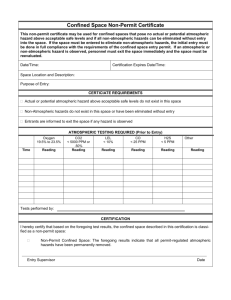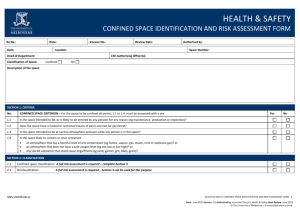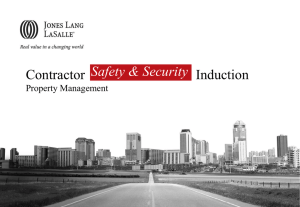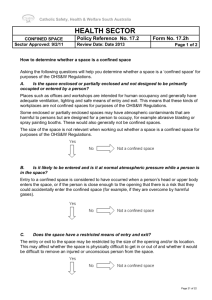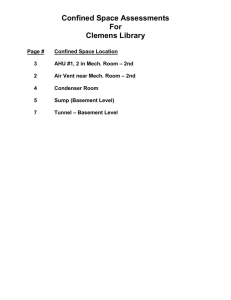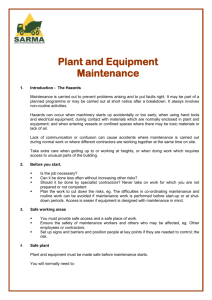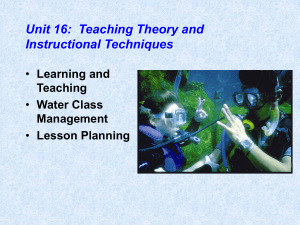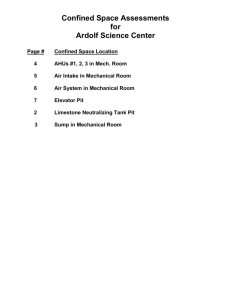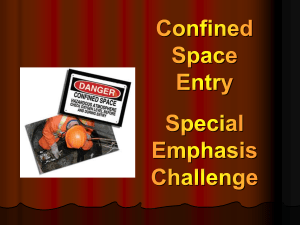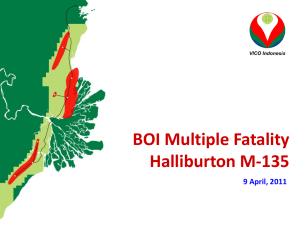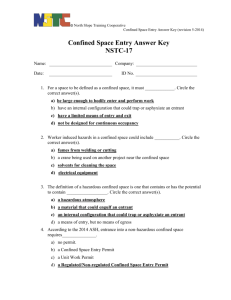CONFINED SPACE ASSESSMENT
advertisement
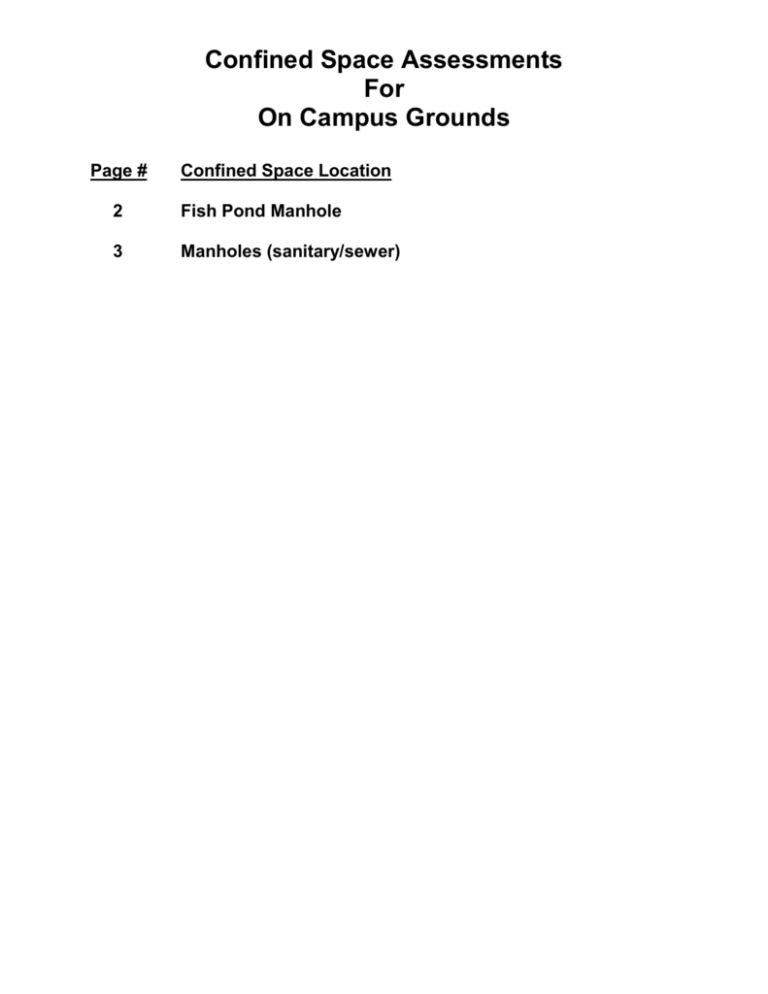
Confined Space Assessments For On Campus Grounds Page # Confined Space Location 2 Fish Pond Manhole 3 Manholes (sanitary/sewer) CONFINED SPACE ASSESSMENT Decision: Permit Required Non-Permit Building: On Campus Grounds Confined Space Location: Fish Pond Manhole Date of Assessment: September 10, 2003 Conducted By: Purpose of Entry: Repair and maintenance NO. 1 To determine if the space listed above is a confined space, highlight the response that best applies to the space being evaluated. The space is large enough and is so configured that an employee can bodily enter and perform assigned work. YES NO The space has limited or restricted means of entry or exit. (i.e. tanks, vaults, vessels, silos, storage bins, hoppers, pits, diked areas) YES NO The space is not designed for continuous employee occupancy. YES NO If ALL three of the above statements were answered YES, the area being evaluated is a CONFINED SPACE. Continue to the next section to determine if it is a “PERMITREQUIRED” confined space. If ANY of the above statements were answered NO, check the following box and proceed no further. The area does not qualify as a “confined space.” NO. 2 Use the following section to determine if it is a “permit-required” confined space. The space contains, or has the potential to contain a “hazardous atmosphere”. Check all those that apply. YES NO ______ Flammable gas / vapor / mist Fuel supply locked out/disconnected ____ Oxygen conc. below 19.5% or above 23.5% _____ Airborne combustible dust conc. > or = its LFL. Dust obscures vision @ 5 feet or less. _____ Atmospheric concentration exceeding the PEL or dose for any substance published in subpart G or Z. ______ Any other atmospheric condition that is IDLH. (i.e. poor ventilation, migrating vapors / gases) _____ Other: (inerting gases, etc) The space contains a material that has the potential for engulfing an entrant (i.e. fill or plug respiratory tract, cause death by crushing, constriction or strangulation) The space has an internal configuration such that an entrant could become trapped or asphyxiated. Check all those that apply. YES NO YES NO _____ Converging walls / downward sloping floors _____ Constriction / taper to a smaller cross-section _____ Difficult to exit / inadequate access / obstacles _____ Other: The space contains other recognized serious safety or health hazards. Highlight yes or no, then check all those that apply. YES _____ Poor or difficult communication _____ Noise / vibration _____ Equipment startup / mechanical hazard _____ Inadequate light / poor visibility _____ Hot or cold contact / extremes _____ Slip & trip surfaces, fall from heights _____ Electrical shock Water? Lights _____ Sharp objects / falling objects _____ Release of stored & hazardous energy _____ Unknown contents / sludge / residue _____ Flooding / avalanche of materials / engulfment _____ Radiation _____ Toxic chemicals _____ Atmospheric contaminant NO _____ Corrosive materials _____ Chemical reactivity CONFINED SPACE ASSESSMENT Decision: Permit Required Non-Permit Building: On Campus Grounds Purpose of Entry: Confined Space Location: Manholes (sanitary/sewer) Date of Assessment: September 10, 2003 Repair and maintenance Conducted By: NO. 1 To determine if the space listed above is a confined space, highlight the response that best applies to the space being evaluated. The space is large enough and is so configured that an employee can bodily enter and perform assigned work. YES NO The space has limited or restricted means of entry or exit. (i.e. tanks, vaults, vessels, silos, storage bins, hoppers, pits, diked areas) YES NO The space is not designed for continuous employee occupancy. YES NO If ALL three of the above statements were answered YES, the area being evaluated is a CONFINED SPACE. Continue to the next section to determine if it is a “PERMITREQUIRED” confined space. If ANY of the above statements were answered NO, check the following box and proceed no further. The area does not qualify as a “confined space.” NO. 2 Use the following section to determine if it is a “permit-required” confined space. The space contains, or has the potential to contain a “hazardous atmosphere”. Check all those that apply. YES NO ______ Flammable gas / vapor / mist Fuel supply locked out/disconnected ____ Oxygen conc. below 19.5% or above 23.5% _____ Airborne combustible dust conc. > or = its LFL. Dust obscures vision @ 5 feet or less. _____ Atmospheric concentration exceeding the PEL or dose for any substance published in subpart G or Z. __X___ Any other atmospheric condition that is IDLH. (i.e. poor ventilation, migrating vapors / gases) _____ Other: (inerting gases, etc) The space contains a material that has the potential for engulfing an entrant (i.e. fill or plug respiratory tract, cause death by crushing, constriction or strangulation) The space has an internal configuration such that an entrant could become trapped or asphyxiated. Check all those that apply. YES NO YES NO _____ Converging walls / downward sloping floors _____ Constriction / taper to a smaller cross-section _____ Difficult to exit / inadequate access / obstacles _____ Other: The space contains other recognized serious safety or health hazards. Highlight yes or no, then check all those that apply. YES __X__ Poor or difficult communication _____ Noise / vibration _____ Equipment startup / mechanical hazard __X__ Inadequate light / poor visibility _____ Hot or cold contact / extremes _____ Slip & trip surfaces, fall from heights _____ Electrical shock Water? Lights _____ Sharp objects / falling objects _____ Release of stored & hazardous energy __X__ Unknown contents / sludge / residue _____ Flooding / avalanche of materials / engulfment _____ Radiation __X__ Toxic chemicals __X__ Atmospheric contaminant NO _____ Corrosive materials _____ Chemical reactivity
